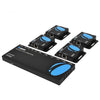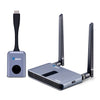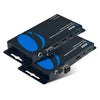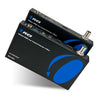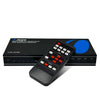What Is an HDMI Matrix Switch and How Does It Work?

An HDMI matrix switch is a device that allows you to route HDMI signals from multiple sources to multiple displays. All matrix switches usually consist of HDMI input and output ports, and a “switch matrix” that can control which input signals are routed to which output signals.
The “switch matrix” is what sets an HDMI matrix switch apart from other HDMI distribution devices like HDMI splitters and switches. With a switch matrix, it can route any input signal to any output signal, allowing for more flexibility and control.
How Is It Different From An HDMI Switch to An HDMI Splitter?
An HDMI switch allows you to connect multiple input sources to a single display. For example, through an HDMI switch, you can connect your cable box, tablet, laptop, and computer to one television and easily switch between your input sources to decide which one you want to display on your TV.
An HDMI splitter allows you to split a single HDMI source into multiple outputs. Splitters are commonly used in events, such as restaurants, prayer halls, churches, conferences, live shows, concerts, social gatherings and more. With a splitter, you can place multiple displays across your event space and have your whole audience watch the same content simultaneously.
An HDMI matrix switch combines the capabilities of both an HDMI switch and an HDMI splitter, allowing you to connect multiple sources to multiple displays and switch between them as needed. For example, you might have a Blu-ray player, a cable box, and a gaming console connected to the inputs of your HDMI matrix switch, and a TV and a projector connected to the outputs. You could then switch between these sources and displays as needed, without having to manually unplug and replug HDMI cables.
What Are The Capabilities Of An HDMI Matrix Switch?
The capabilities of an HDMI matrix switch vary. However, there are some features that are common to many HDMI matrix switches.
One important capability of an HDMI matrix switch is the ability to handle different HDMI resolutions. For example, some HDMI matrix switches support 4K resolutions, while others may only support 1080p or lower. If you have a 4K TV and sources that can output 4K signals, you'll want to make sure your HDMI matrix switch can handle those signals.Another is the ability to handle different audio formats. Many HDMI matrix switches support standard audio formats such as Dolby Digital and DTS, while others may support more advanced formats such as Dolby Atmos and DTS:X. Make sure your HDMI matrix switch can handle the audio formats you require if your home theater has a surround sound system.
HDMI matrix switches may also include features such as remote control, web-based control, and scheduling. For example, you may be able to program your HDMI matrix switch to switch between inputs and outputs at specific times of the day, or you may be able to control it from anywhere in your home using a smartphone app.
Where Can You Use An HDMI Matrix Switch?
To shed more light on how HDMI matrix switches are used in real-world applications, here are a few examples.
-
Home Theaters
An HDMI matrix switch is perfect if you want to level up your home theater. Easily decide what you want to show between a Blu-ray player, a computer, or a streaming device on your wide-screen TV or projector. If you want, you can even watch the same content on multiple displays at the same time.
-
Conference Rooms
In a conference room setting, an HDMI matrix switch can help you connect multiple laptops or other devices to multiple displays for presentations or video conferencing. This is useful if you have multiple presenters or if you want to display different content on different displays.
-
Retail Stores
With an HDMI matrix switch, you can display content on multiple screens throughout your entire store. For example, if you currently have store promotions going on, you may display them simultaneously across all available displays so they can engage more customers and generate more sales.
What Are The Benefits Of Using An HDMI Matrix Switch?
Here are some HDMI matrix switch benefits that you should know if you’re still wondering why you should get one.
- Greater flexibility: With an HDMI matrix switch, you can connect multiple sources to multiple displays and switch between them as needed. This gives you greater flexibility and control over your audio and video setup.
- Simplified cabling: Instead of having to manually unplug and replug cables every time you want to switch between sources and displays, an HDMI matrix switch allows you to do it with just a few button presses.
- Cost savings: Instead of having to purchase multiple HDMI switches and splitters to achieve the same functionality, an HDMI matrix switch allows you to do it all with a single device. This can save you money and reduce clutter in your home theater or conference room.
- Improved user experience: With an HDMI matrix switch, you can create a seamless and intuitive user experience . Whether you're watching a movie, giving a presentation, or shopping in a retail store, an HDMI matrix switch can help you create a more engaging and enjoyable experience.
Of course, the last question you probably have in mind is how much an HDMI matrix switch costs. The best HDMI matrix switches are certainly priced higher, and will highly differ depending on your needs, but you can get an Ultra HD 4x2 HDMI matrix switch for as low as $59.99
Before buying an HDMI matrix switch, list down all your requirements. How many input and output devices do you have, and what are their display and audio capabilities? Do you need an HDMI matrix switch that supports ARC? Do you need one that can support up to 8K resolution? Once you have your list, you may now start browsing through our list of HDMI matrix switches in our shop. We included all relevant information to support you in your buying process. Each product has its detailed specifications, along with sample applications, reviews, and FAQs.
Check out more great reads on other types of HDMI distribution devices in our blog and learn more about what type of HDMI device you need.


